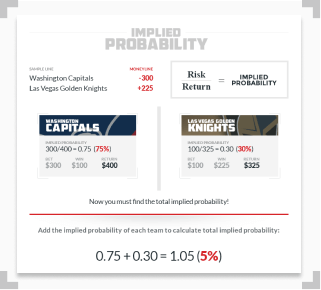Beating the Juice: How to Remove the Vig from Sports Betting Lines

- Sportsbooks take a cut of every bet placed on a sporting event, called the ‘juice’ or ‘vig’
- The vig influences odds, so you need to remove it for a clear picture of likely outcomes
- Learn how to remove the vig to place smarter bets with this guide
“Vig” (also known as vigorish or ‘juice’) refers to the fee a bookmaker or sportsbook charges a bettor for placing their wager. The vig allows the bookmaker or sportsbook to make money on every betting line, regardless of the actual outcome of the event. Bettors win and lose, but the right vig guarantees the bookies always win.
Sportsbooks collect the vig by adding it into the odds as overround, or setting probabilities such that the total implied probability of all potential outcomes exceeds 100%. Because it’s baked into the odds as overround, the vig will shift the numbers, so you need to remove it to gain an accurate picture of what bookmakers actually expect to happen in a game.
Check out our comprehensive guide if you want more detail on how and why your favorite sportsbooks take their cut.
How to Read and Calculate Sport Odds
Before you can remove the vig from the line, you need to be confident effectively reading sports odds.
You’ve probably have seen a spread similar to this:
- L.A. Rams: -3.5 -110
- Seattle Seahawks: +3.5 -110
The -110 indicates that for the bettor must wager $110 for every $100 they want to win.
The $10 withheld from the bettor is the vig, which the bookmaker or sportsbook keeps as their profit.
If you need a hand converting odds, check out our guide on how to read and calculate sports betting odds.
Why You Should Remove the Vig
Sportsbooks are in the business of dealing risk, but they like to play things safe themselves. Their goal with any betting line is to ensure the money comes in on each side in optimal proportions, such that they can cover their payout obligations while still pocketing some for themselves. This is one reason the odds will change in the lead up to an event: to attract more action on one side of the line, or to include a higher ‘vig’ percentage to guarantee profit.
Because the odds consider profitability rather than likely outcomes alone, you need to remove the vig from the betting line to gain an accurate picture of the actual probabilities oddsmakers assign to each potential outcome. We refer to this as ‘actual probability’ to differentiate it from ‘implied probability,’ which includes juice in the form of overround.
Finding this actual probability will help you handicap your wagers by getting a clearer view of the oddsmaker’s expectations. This exercise allows you to compare how much the sportsbook has inflated the price on a betting line, or to compare the handling fees baked into the odds at two different sportsbooks.
That said, it’s key to remember that you are ultimately wagering on the odds as they’re offered. When analyzing the potential value of any given bet, you should compare your estimated probability with the implied probability suggested by the odds with the vig included.
How to Calculate No Vig Odds and Remove the Juice
There are a number of calculations that need to be completed to remove the vig and look at the actual probabilities oddsmakers have assigned to each outcome of an event. Follow the following steps for a ‘clean line’ that isn’t influenced by the money coming in on each side:
- Calculate implied probability (including the vig) of all outcomes.
- Total implied probability includes overround, and we can use this value to find the vig as a percentage, or to remove it from the betting line.
- Calculate actual probability by removing the overround (which also removes the vig) to bring total implied probabilities to 100%.
- Compare actual probability with your own handicapping efforts to determine if a line has value.
How to Calculate Implied Probability
The formula to find implied probability is risk/return = implied probability.
As an example, let’s find the implied probability of the following NHL moneyline:


In this scenario, you’ll need to bet $300 to win $100 (with a total return of $400).
Using the above formula of risk/return: 300(risk)/400(return)=0.75. The 0.75 number, or 75%, is the implied probability of the Capitals winning.
For the Vegas Golden Knights you would calculate: 100(risk)/325(return)= 0.30. 30% is the implied probability of the Golden Knights winning.
Now, you’ve got to determine the total implied probability, also known as the overround. To do so, you add each team’s implied probability, which would be .75 + .30 = 1.05, or 105%.
As you can see, the sum of total implied probabilities is more than 100. By effectively taking wagers on a range of outcomes that’s greater than the actual possible outcomes, overround is a simple way for bookmakers to guarantee they take in more money than they pay out. In the example above, the bookmaker would expect to pay out $100 after receiving $105 worth of wagers.
How to Calculate the Vig as a Percentage
The vig is technically defined as the associated percentage amount the sportsbook will profit on the line. Overround can be used to calculate this percentage using the following formula:
Vig = 1 – (1/Overround) x 100
Vig = 1 – (1/105) x 100
Vig = .0476
Vig = 4.76%
It’s worth noting that you don’t need to calculate the vig as a percentage to find actual probability, or the implied probability of each outcome before books add the vig.
How to Calculate Actual Probability (Odds without the Vig)
You must remove the overround to find actual probability by dividing each team’s implied probability by the total implied probability (or overround).
Actual probability = team implied probability/total implied probability
So 75.00/105.00 = .71 or 71%. The actual probability of the Capitals winning is 71%.
30.00/105.00= .29 or 29%. The actual probability of the Golden Knights winning is 29%.
To confirm you have done your calculations correctly add up both of your actual probabilities. The total should be 100 or 1, as a percentage or decimal, respectively:
.71 + .29 = 1.00. or 100%.
By removing the overround, we can see the actual probabilities of each outcome as estimated by the bookmakers before they account for the vig.
Actual Probability Provides an Inside View
Removing the vig provides a behind the scenes viewpoint for sports bettors. If you don’t remove the vig or juice, you won’t know what the sportsbook actually thinks is going to happen in the game.
Calculating the vig on a betting line also helps you identify those bets that are simply overpriced.
For more great articles on sport betting tactics and tips, check out our guide to the sharpest strategies in the business.

Evergreen Writer/Editor; Sportsbook Expert
With nearly two decades of experience in sports media, Paul Costanzo turned his professional attention to sports betting and online gambling in January of 2022. He's covered every angle of the industry since then, managing and creating content for PlayMichigan and The Sporting News, and now SBD.



